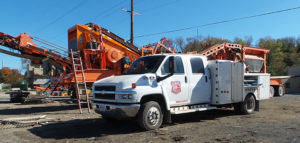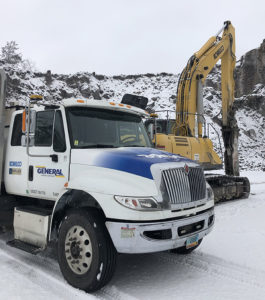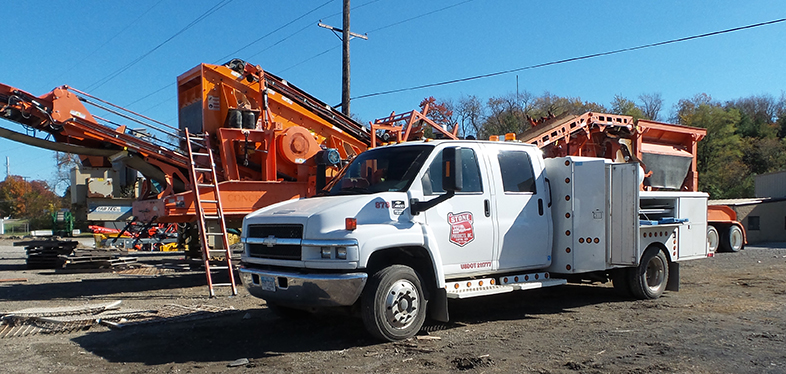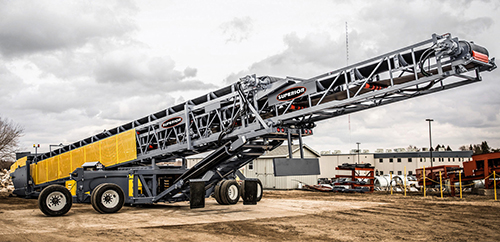
The plant just went down, and a phone call to a local dealer is in the works.
The phone rings once, then twice and again a third time before going to voicemail. The aggregate producer leaves a message and makes yet another call shortly afterward, but the workday ends with the producer still waiting for a response.
In the meantime, the plant remains down and a feeling of despair takes over the producer.
“With service, it’s how fast you can get the customer up and running when they break down,” says Tom Kovesci, general manager at Stone Products, a dealer based in Canton, Ohio.
Randy Martin, safety director at Beaver Excavating, a sister company to Stone Products, couldn’t agree more.
“There’s nothing worse in our day and age when calling somewhere and you get a computer,” Martin says. “If you have a person who answers your call, you’re a lot happier.”
Prioritizing producers
Producers aren’t the only ones conditioned to expect immediate responses when it comes to service. With companies like Amazon and others taking product delivery to new heights, consumers expect answers immediately.
Not tomorrow, but today in so many instances.
“We are a society that wants everything instantaneously,” says Chris Harris, con/agg manager at Ohio Cat. “Everything has to happen right now.”
In a dealer’s world, this expectation means keeping parts in stock and customers up to date with need-to-know information.
“No customer ever wants to hear you say: ‘I’ll get there next week because I have all of these other guys to handle first,’” Harris says. “When you do that, you’re basically saying they’re way more important than you are.”
If a dealer’s response means putting a service technician on a plane, then that’s what must be done to get the producer back up and running.
“The service side is so underrated,” says Micah Tysver, sales manager at General Equipment & Supplies. “It is so important. We pride ourselves in our service department and feel we have some of the best service technicians in the industry. They’re not afraid to jump in a service truck or even on an airplane in the pandemic to get to a site that’s too far to reach by road.”
Delivering quality service also means making those visits when it’s inconvenient, like on holidays or the weekend. As much as dealers want to settle in at home for an enjoyable Fourth of July, the backyard barbecue will have to wait if a customer comes calling.
But delivering solutions during those critical times separates the good dealers from the great ones.
“Customers want you to come on those holidays,” says Larry Hetzel, owner and CEO of Rock Machinery Co., based in Allenton, Wisconsin. “There’s a need to work when customers want us there, day or nighttime, because they cannot afford downtime.
Bryant Fazer, president and sales manager at Rock Machinery Co., echoes Hetzel’s sentiment.
“Nights, weekends, holidays – we’ve done a lot of it,” Fazer says. “It’s 24/7/365. If a customer has a problem, if we sold it to them or not, if there’s something we can do to physically help them, we’ll do it.”
Critical characteristics

Still, just anyone can show up. Does the dealer responding have the knowledge and experience to deliver the service the producer needs? These components are part of the service expectation, as well.
“Years of experience is so key as opposed to having bodies that check off boxes,” Hetzel says.
Sy Harrison, COO at Goodfellow Corporation, echoes Hetzel’s sentiment.
“It’s quality of service techs,” Harrison says. “We all sell expensive equipment, and it breaks down a lot. It’s how you handle those situations. If you’re as freaked out as the customer is, that’s not good. Instead, you can say ‘I don’t know, but we’ll get there and figure it out.’”
As Tysver describes, so much of the equipment General Equipment services requires specialized software and tools to diagnose and repair. The average operator does not have these resources, he says, so dealers are leaned on even more these days to effectively service the equipment and technology used in the field.
“There are some young dealers out there who’ve been dealers for five or 10 years,” Tysver says. “You see the dealers who have survived during that period, and the majority of them have a service department.”
A dealer’s livelihood can depend on their ability to deliver service, Tysver adds.
“I was talking to a dealer that doesn’t have a service department,” he says. “They do stationary aggregate equipment only. Anytime they need to do repairs or specialized maintenance, they rely on manufacturers. But manufacturers aren’t always available, so they look for different crews.
“Now that they’ve been around five or six years, they realize they have to be a service department,” Tysver adds.
The tech opportunity
While service in the aggregate industry is largely driven around the in-person experience, dealers are finding more opportunities to provide solutions virtually. A scenario Harris experienced at Ohio Cat illustrates this point.
Harris was on a service call when he encountered an issue requiring the attention of a service technician. But rather than the service tech making the trip to the jobsite, Harris pulled out his smartphone and brought the tech onto the site virtually.
By holding his phone up to the area of the equipment in question, Harris got the answers from the tech he needed to move forward.
“That probably saved me a trip charge and an hour’s worth of service time – and probably hundreds of dollars – with a 30-second FaceTime call,” Harris says. “Do this and this, and you’re fixed.”












